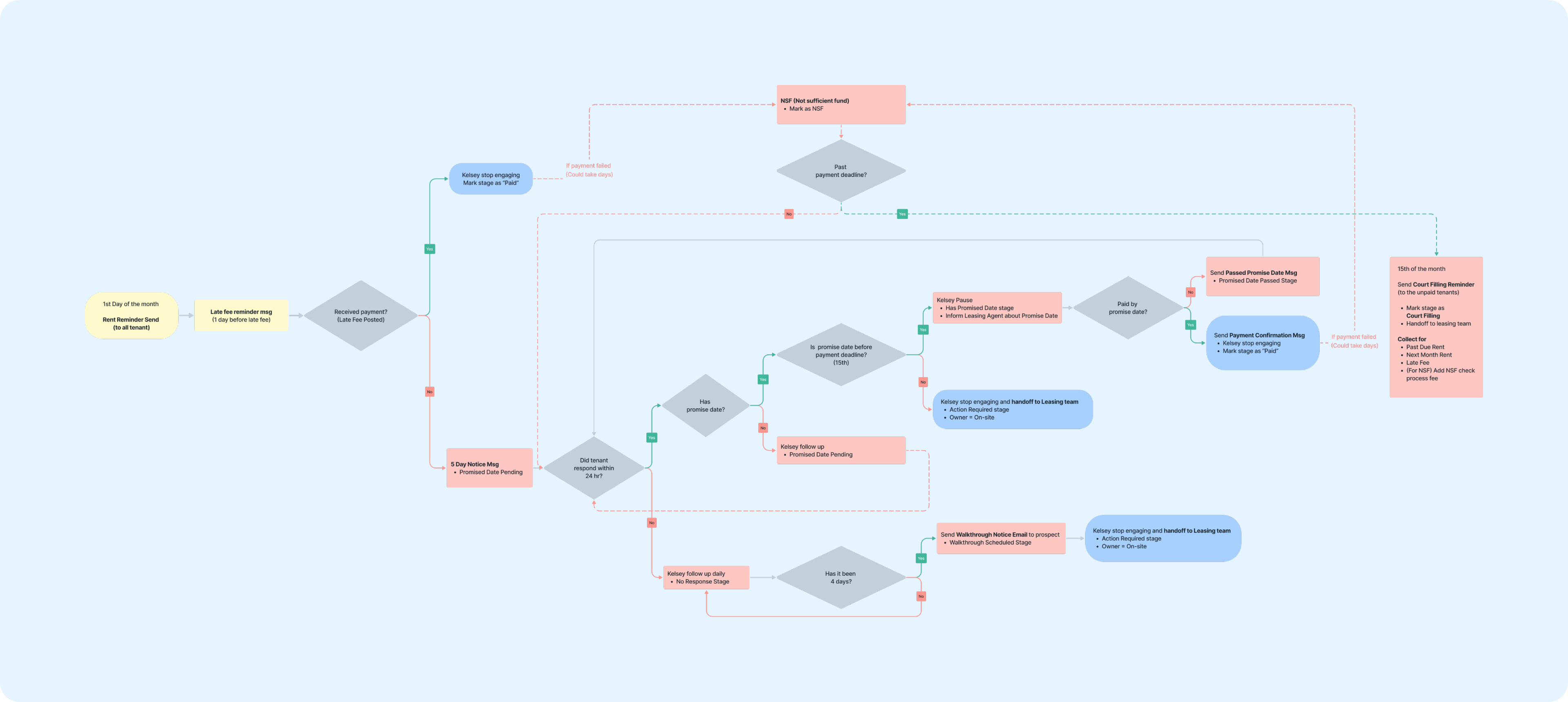Turning manual chaos into automation that cut rent collection time by 85% and reduced delinquencies by 40% across communities.

Background
Before Rent Collection, Zuma focused on automating leasing inquiries with AI. The company had never built for the resident experience, a space shaped by complex regulations and the emotional friction around payments.
When I joined as the Product Designer, the CPO had an initial vision for a rent collection tool but no clear plan for how it would actually function. I partnered closely with the CPO and engineers to define the roadmap, conduct user discovery with early design partners, and design the first scalable version of the product.
My Role
Sole Product Designer (0 → 1) for Rent Collection
Product discovery and field research
Usability testing and hi-fi prototyping
Defined AI messaging & automation rules
Roadmap planning & feature prioritization
Wrote technical PRDs
The Problems
Rent collection was easily one of the least-loved parts of an on-site team’s day. Most leasing agents still relied on sticky notes, handwritten paper and thick binders to track who paid and who didn’t.
Before Zuma, agents spent roughly 20~30 hours a month hunting down late payments, sending emails, and making those awkward “just checking in about your rent...” calls. Let’s be honest, no one enjoys being the bad guy chasing payments.
HMW reduce the manual workload of rent collection for on-site teams while staying compliant across states and keeping leasing agent in loop?
Process & Solution
As the sole designer, I worked with the CPO and engineering manager to take Rent Collection from 0 to 1. I conducted research, defined product structure, created PRDs, and designed the MVP.
After launch, I took on additional PM responsibilities: setting roadmaps, tracking KPIs, working with support to identify user pain points, and integrating client feedback into each iteration.
Discovery
I spent significant time shadowing leasing agents across different states and running discovery sessions with our two early design partners.
These sessions revealed three key insights that shaped the direction of the product:
These discoveries guided the core product principles:
Automating the Manual Work
Based on these insights, I designed an automated messaging flow covering nearly every step of rent collection, eliminating manual tracking and communication.
To give leasing teams visibility, the MVP also included daily automated email reports with payment status, balances, and collected promise dates, instantly replacing manual logging.
I also automated the Promise to Pay date collection process, where AI asked residents who couldn't pay immediately to provide a specific date and included those promises in the daily report.

Configurable Templates for Complex Rules
Since every state and management company operated differently, I designed a configurable workflow builder that allowed teams to create templates with region-specific rules.
Communities linked to that template automatically followed its rules but could still customize knowledge base content, payment links, and Late Fee Structures.
This flexibility allowed Zuma to roll out Rent Collection to three additional enterprise clients beyond the two design partners without extra engineering work, proving the system's scalability and validating our configuration-first approach.
Translating Real Behaviors into Automation
Through user research, I discovered that "walkthrough notices" (physical reminders placed at residents' doors) were extremely effective at prompting action.
These notices warned residents that their leasing agent would be entering their unit the next day, triggering immediate action due to the fear of consequences.
I translated this insight into a digital flow: if a resident didn't respond after a configurable period, an automated message warned them that their leasing agent would "key" their unit.
This digital approach triggered the same resident behavior and sense of urgency without requiring staff to physically visit each unit and became the product's unique selling point.

Chrome Extension for Seamless Adoption
Many leasing agents preferred not to learn new app or juggle multiple systems. To keep them in the loop, I designed a Chrome extension that surfaces AI-resident conversations, highlights any required follow-up actions, and gives agents clear visibility into what Kelsey AI has communicated.
Agents can quickly log promise-to-pay dates, update walkthrough results, or record other key outcomes, ensuring human input is captured immediately and complementing the automated workflow. This closes the loop between AI, leasing agents, and residents, combining automation with human judgment for a seamless, collaborative rent collection experience.
Metrics & Outcomes
Leasing agents described the system as “simple and stress-free,” a major success given their initial hesitation with AI.
Takeaways
Design for real-world behavior
Recreating the “walkthrough notice” digitally succeeded because it mirrored real behavior that already motivated residents to act.
Empathy drives adoption
Meeting users in their existing workflows (email, browser, minimal context switching) reduced resistance and was critical for adoption.
Unexpected new possibilities
Automating resident communication opened doors beyond rent collection. Residents began using the system to ask about lease renewals and maintenance requests, revealing new opportunities to expand Zuma's AI communication ecosystem.
What I Can Improve
Advocate for balanced delivery and quality
Shipping under tight deadlines taught me to balance short-term delivery against technical debt, which later slowed our ability to iterate quickly. In future projects, I'd push for more dev time upfront to build stability while maintaining velocity.
Improve PM & cross-functional skills
Stepping into a PM-like role highlighted areas to improve: I can strengthen my technical PRD writing to better anticipate edge cases and ensure tighter alignment with engineering, design, and support teams.
Design more context-aware solutions
While the Chrome Extension eased adoption, it still has its fair share of complexity. For responding to residents, it would be even more seamless if we allowed users to respond directly via email, since we already send email notifications for resident responses that require their attention.